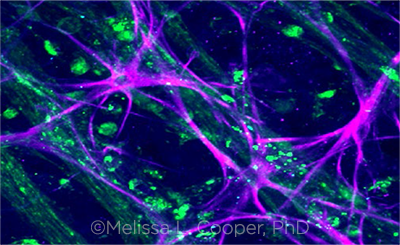Download PDF
As storehouses for glycogen, astrocytes are known to nourish optic nerves by funneling large amounts of metabolic energy (for example, lactose) to the retinal ganglion cell axons, which transfer visual signals to the brain. But new research has revealed that the astrocytes in a healthy optic nerve play a key role in responding to neurodegenerative signals from the contralateral, glaucomatous eye: The astrocytes begin donating some of the healthy optic nerve’s metabolic resources to the nerve from the eye with glaucoma.1
Ironically, this redistribution of available energy weakens the healthy optic nerve and may explain why glaucoma that begins in one eye often “spreads” to the other eye, said senior author David J. Calkins, PhD, at the Vanderbilt Vision Research Center in Nashville, Tennessee.
 |
ENERGY TRANSFER. Astrocytes (purple) in the mouse retina interconnect via gap junctions to form a plexus that covers retinal ganglion cells and their axons (green), which form the optic nerve to the brain.
|
Novel finding. “This is the first time anyone has demonstrated the sharing of energy resources between the two eyes and nerves,” Dr. Calkins said. “But unfortunately, because these resources are limited, the nerve that donates the resources becomes more susceptible to intraocular pressure–related stress in glaucoma.” Thus, he said, “Over time the pathology in the two optic projections to the brain equilibrates, endangering both optic nerves.”
Murine model. Working with a mouse model of glaucoma, the scientists found that astrocytes used gap junctions to transport metabolites along the long distance from one optic nerve, through the optic chasm, to the other optic nerve. (In a human, this would correspond to several centimeters, Dr. Calkins said.)
The movement was facilitated by connexin 43 (Cx43), an essential protein, the researchers reported. In the absence of Cx43, this protective response to oxidative and metabolic stress did not occur.
Dr. Calkins said the group’s next step is to build a viral vector modified to upregulate the astrocytes’ capacity to store glycogen and exchange energy. “Basically what we’re trying to do is build and bootstrap energy depots large enough to keep both optic nerves healthy,” he said.
A role in other neurodegenerative diseases? It is possible that a similar astrocyte-mediated rescue mechanism is at work in other neurodegenerative conditions, Dr. Calkins said. For instance, in patients with Leber hereditary optic neuropathy who have undergone gene therapy and in patients with the Argus II retinal implant (Second Sight), there have been reports that the untreated eyes show unexplained visual improvement, he said. And Alzheimer disease lesions in one brain hemisphere commonly appear in the other hemisphere over time, he said.
Call for research. “I think we need to put more research into understanding how the two optic projections can talk to one another,” Dr. Calkins said. “The gap junctions between astrocytes are large enough to pass different kinds of molecules.” He added, “This is exciting because it opens up entire new avenues for understanding how pathology spreads between the two eyes.”
—Linda Roach
___________________________
1 Cooper ML et al. Proc Natl Acad Sci U S A. 2020;117(31):18810-18821.
___________________________
Relevant financial disclosures—Dr. Calkins: None.
For full disclosures and the disclosure key, see below.
Full Financial Disclosures
Dr. Calkins None.
Dr. Hammond None.
Dr. Kempen CBM: S; Gilead: C; NEI: S; Sight for Souls: S. In addition, the MUST Trial received a donation of fluocinolone acetonide intraocular implants from Bausch + Lomb for patients who would be unable to enroll in the trial without a donated implant.
Dr. Lim Heidelberg Engineering: L; National Healthcare Group Eye Institute, Tan Tock Seng Hospital: S; Novartis: C.
Disclosure Category
|
Code
|
Description
|
| Consultant/Advisor |
C |
Consultant fee, paid advisory boards, or fees for attending a meeting. |
| Employee |
E |
Employed by a commercial company. |
| Speakers bureau |
L |
Lecture fees or honoraria, travel fees or reimbursements when speaking at the invitation of a commercial company. |
| Equity owner |
O |
Equity ownership/stock options in publicly or privately traded firms, excluding mutual funds. |
| Patents/Royalty |
P |
Patents and/or royalties for intellectual property. |
| Grant support |
S |
Grant support or other financial support to the investigator from all sources, including research support from government agencies (e.g., NIH), foundations, device manufacturers, and/or pharmaceutical companies. |
|
More from this month’s News in Review